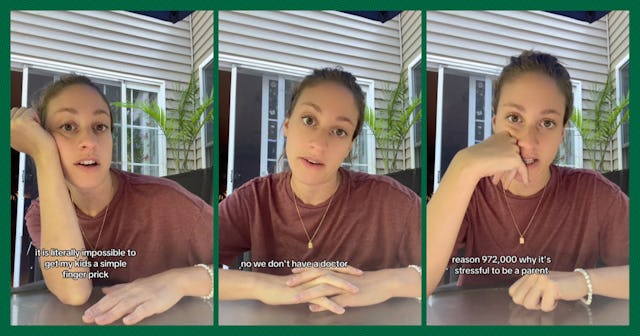Mom Highlights The Real Life Consequences Of The Pediatrician Shortage
Even getting a required, a routine test can be a struggle with no clear answer.

Having kids is great, but sometimes taking care of them is a full-time job. And we’re not talking about simply caring for them (though that, too, is a full-time job). We mean coordinating the things they need outside of our homes: schools and daycares, activities, and, of course, doctor’s appointments. Case in point: Katie, who posts on TikTok as @katiebellaaf20, recently shared difficulties she’s had obtaining a state-mandated, routine test medical for her children in daycare.
“Reason 972,000 why it’s stressful to be a parent,” she begins.
She elaborates that her children do not have a pediatrician since the family moved. The office where Katie wants her children to be seen has a waitlist that they have been on since this April. This hasn’t been a day-to-day bother: urgent care is available if the kids get sick. But, a state mandate states that they must have a current lead screening to be able to attend daycare. Katie called the pediatrician only to be told that the wait list would be going strong through at least November, and because her children were not patients they could not perform the test, which is done via a finger prick or a small amount of blood taken from a vein. It’s a very simple procedure... when you can get it.
So Katie’s scramble began — clinics and labs all around town refused to carry out the test without an order from a doctor... and since Katie’s family doesn’t currently have a pediatrician, they can’t get one.
One of the many ER departments she called said they were “pretty sure” they could do it, but when she arrived there was a four to six hour wait and no chairs available.
“I have two healthy toddlers,” Katie says. “And I’m supposed to stay in this waiting room for four to six hours? I don’t have enough activities in my diaper bag for that!”
“What am I supposed to do?” she asks. “I’ve got them on three different wait lists for pediatricians. There is no one who can take us right now. ... It is literally impossible to get my kids a simple finger prick.”
Katie isn’t alone in her difficulty in finding care for her children. According to reporting from PBS News, medical students opting for a pediatric specialty have steadily declined over the past several decades. While 2024 saw record levels of medical school graduates seeking residency programs, it also saw the steepest drop in those choosing pediatrics: a 6.1% decline, which led to nearly 30% of hospital pediatric departments not filling their positions.
But why? Speaking to NPR, Dr. Jeanine Ronan, program director of the pediatrics residency program for the Children's Hospital of Philadelphia, says the issue is “multifactorial” and also not entirely understood.
“[Pediatrics is] definitely not the focus of the preclinical training you receive before you go on to the clerkships and get a chance to take care of patients clinically,” she offers. “Usually some of the unique diseases that we see in pediatrics, which actually, to me are some of the really exciting aspects, the medical students don't get as introduced to those as early on. I also think, post the pandemic, pediatrics has really had a change in the types of problems we're seeing and the types of patients that are getting admitted to the hospital ... I think some people's experience in pediatrics, as a medical student, has also changed a little bit.”
And of course, there’s money: pediatrics as a speciality is paid far less than most other specialities. Dr. Sallie Permar, Head of Pediatrics at Weill Cornell Medicine told PBS News that this was due in large part to the fact that many children are insured by Medicaid, which pays considerably less for care than Medicare, which is available to older people.
That’s not an indictment against medical students or doctors. The average medical school debt, according to the Education Data Initiative (EDI), is $264,519. (To put that in historical perspective, EDI says that in 1978, the average medical school debt in the U.S. was $13,500 which is equivalent to $64,534 in 2024.) New doctors have to carefully consider not just their passions and desire to help, but how they’re going to pay off the loans that made their careers possible.
But what about the families left without care? What can we do? Telehealth, which has become increasingly popular since the pandemic, is one option. Local hospitals are a great resource, since they’ll have a roster of any doctors affiliated with their system to help narrow your search. Urgent care is totally serviceable for sick visits or even minor emergencies, like stitches. Concierge medicine, while more expensive (you pay a yearly fee, which can range from about $1,500 to $20,000 depending on the services you’re seeking) can give clients faster access to care (since fewer people can afford the service).
But there will be times when a particular service, as with Katie, is simply going to be harder to access due to this shortage... which unfortunately doesn’t look like it will be getting better any time soon.